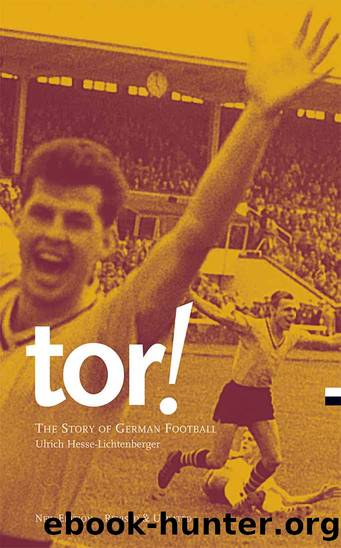Tor! The Story of German Football by Uli Hesse

Author:Uli Hesse [Hesse, Uli]
Language: eng
Format: epub
Publisher: WSC Books
Published: 2011-05-19T22:00:00+00:00
Three 1954 World Cup winners were still in action when the brand-new league kicked off in 1963. Helmut Rahn was back from Enschede and playing for Duisburg, having been dragged out of a Dutch prison cell he was occupying on account of a car accident brought about by too many Heinekens. Hans Schäfer was captaining Cologne. And Max Morlock was still there with Nuremberg â which made him the only player who saw action in the Gauliga, Oberliga and Bundesliga eras.
The first Bundesliga goal was scored by Dortmundâs Timo Konietzka, barely a minute into a game at Bremen that his club eventually lost. Rahn and Morlock scored, too, on this inaugural day. The first own goal befell Willi Schulz, playing for Schalke, a week later. On day four, the first âlicensed playerâ was sent off â Helmut Rahn (he headbutted an opponent). Uwe Seeler won the Golden Boot with 30 goals, Münster and Saarbrücken were relegated, Cologne won the title.
By and large, the mood was excellent. Crowds flocked to the games, having realised that while the number of derbies had decreased, they could now watch a top-level team every second Saturday. There were some crazy games, like Dortmundâs 9-3 win over Kaiserslautern, at a time when only two points separated the teams. And there were mind-benders, like Cologne losing at home to Saarbrücken.
Yet some people still feared this more or less professional nationwide league would irreversibly shake up German football, would produce a few rich, big-city clubs destined to dominate everything, while the underdogs fell by the wayside. Developments in the rest of Europe appeared to bear this out. Between 1929 and 1963, only seven different clubs had won Italyâs Serie A, eight teams had triumphed in Spainâs Primera Liga. Even in England, which admittedly had lost six full seasons to the war, Arsenalâs domination in the Thirties meant only 13 sides were crowned as League champions. In West Germany, however, no fewer than 17 different clubs had won finals for the national title during that span. Since the war, there had never been one team that dominated everything, like the 1920s Nuremberg or the 1930s Schalke sides. Now, it seemed, everything would change. Cologne had grabbed the first Bundesliga title, as expected, and that could only mean they and one or two other well-off, well-prepared big shots would have the say.
And indeed there were signs from different directions in 1963 and 1964 that an age was coming to a close. The eccentric ex-referee Peco Bauwens died, to be replaced at the DFBâs helm by the lawyer and politician Hermann Gösmann. Then Sepp Herberger announced he would step down in late 1964, somewhat piqued that his successor would not be Fritz Walter (who knew he was too tender a character to make a good coach at such a high level) but his long-time assistant Helmut Schön. Helmut Rahn tore his Achilles tendon and finished his career. Morlock and Schäfer retired a year later.
But, as the doom-sayers would soon find out, even in the Bundesliga, the ball insisted on being round.
Download
This site does not store any files on its server. We only index and link to content provided by other sites. Please contact the content providers to delete copyright contents if any and email us, we'll remove relevant links or contents immediately.
Tip Top by Bill James(1004)
Three-Ring Circus by Jeff Pearlman(721)
1312, Among the Ultras by James Montague(586)
Like Streams to the Ocean by Jedidiah Jenkins(523)
One Life by Megan Rapinoe & Emma Brockes(520)
Don Cherry's Hockey Stories and Stuff by Don Cherry(498)
Bruce Lee by John Little(482)
Crossroads by Kaleb Dahlgren(468)
The Dynasty by Jeff Benedict(449)
On Learning Golf by Percy Boomer(439)
The Greatest Game Ever Played by Mark Frost(423)
Maradona: The Boy. The Rebel. The God. by Guillem Balagué(418)
Bravey by Alexi Pappas(390)
The Pocket Samurai by William Scott Wilson(383)
Running Back in Time: Discovering the Formula to Beat the Aging Process and Get Younger (Younger Than Ever Book 2) by Gilkis Dr. Zeev(342)
The Tai Chi Space: How to Move in Tai Chi and Qi Gong (A Pictorial Guide) by Paul Cavel(341)
Powerbuilding Breakdowns by Josh Bryant & Adam benShea(337)
My Life in Red and White by Arsene Wenger(336)
Breathe by Rickson Gracie(334)
